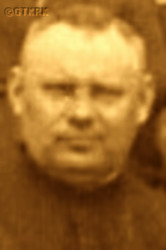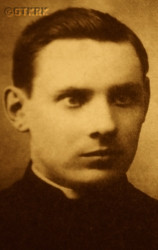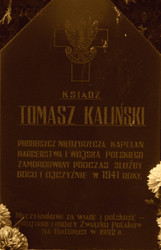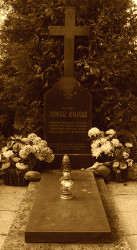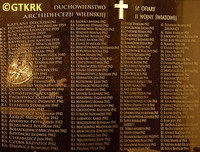Roman Catholic
St Sigismund parish
05-507 Słomczyn
85 Wiślana Str.
Konstancin deanery
Warsaw archdiocese, Poland
full list:
displayClick to display full list

searchClick to search full list by categories
wyświetlKliknij by wyświetlić pełną listę po polsku

szukajKliknij by przeszukać listę wg kategorii po polsku

Martyrology of the clergy — Poland
XX century (1914 – 1989)
personal data
surname
KALIŃSKI
forename(s)
Thomas (pl. Tomasz)
function
diocesan priest
creed
Latin (Roman Catholic) Church RCmore on
en.wikipedia.org
[access: 2014.09.21]
diocese / province
Vilnius archdiocesemore on
en.wikipedia.org
[access: 2013.05.19]
Vilnius diocesemore on
en.wikipedia.org
[access: 2013.05.19]
RC Military Ordinariate of Polandmore on
en.wikipedia.org
[access: 2014.12.20]
honorary titles
„Medal of Independence”more on
„Medal of Independence”
(29.12.1933)
Silver „Cross of Merit”more on
Silver „Cross of Merit”
(09.11.1931)
Commemorative Medal for War of 1918–21more on
Commemorative Medal for War of 1918-21
date and place
of death
25.06.1941

Mizherychitoday: Karolin ssov., Zeľva dist., Grodno reg., Belarus
more on
be.wikipedia.org
[access: 2022.01.06]
details of death
As a young man, while educating himself, worked as a teacher of history and Polish language in a clandestine school run by Elise Orzeszkowa, an outstanding writer, residing in Grodno. Due to the Russian ban on Polish schools, Orzeszkowa ran a „university” for girls in her apartment — in addition to clandestine lessons for boys from Grodno grammar schools.
This happened in the Rus. Гродненская губерния (Eng. Grodno Governorate), established on lands robbed in the 18th century from Polish–Lithuanian Commonwealth, where the Russians pursued a particularly harsh Russification policy. In 1871, they „introduced a ban on the use of the Polish language not only in schools, but also in public places, wearing national costumes and […] using Polish‐style horse‐drawn carriages”. Even after the tsarist decrees on „religious tolerance” from 1905, when Polish elementary schools (mainly parish schools) began to be established en masse, no permits were granted for their operation, thus making them „illegal” and punishing their organizers with financial penalties and even imprisonment. And in 1908, the Russians once again formally removed the Polish language from elementary schools.
Despite this, continued to participate in secret teaching, including in Rusaki village, from where in 1910, due to the threat of arrest, had to flee. Moved to Sosnowik village, about 15 km away, where also conducted secret teaching of children (himself continuing his education in nearby Sokółka).
During World War I, after the Russian defeat in the Battle of Gorlice in 05.1915, fled with c. 3 million Russians — representatives of the Russian occupation apparatus: officials, soldiers, teachers, etc. — to the east (the so‐called bezhenstvo). Settled in Babruysk. In 05.1918, after in 03.1918 the Russian Bolsheviks signed a separatist peace treaty with the Central Powers (Germany, Austria–Hungary) in Brest, returned to Polish lands.
During the Polish–Russian War of 1919‐1921, chaplain of the Polish Army. In the summer of 1920, during the Russian offensive threatening the Polish state, became chaplain of the 2nd „Siberian” Infantry Regiment, part of the Siberian Infantry Brigade, formed from 14.07.1920 in Pomerania (e.g. in Grupa near Grudziądz and Toruń), among others from the remnants of the 5th Polish Rifle Division, formed earlier in 1919 in Siberia, from Poles working there and children and grandchildren of Polish exiles, most of which capitulated to the Bolsheviks, although some soldiers managed to return to the country. In the first decade of 08.1920, the brigade was sent to Zegrze, to the front, and subordinated to the 5th Army, under the command of Gen. Vladislav Sikorski. From 14.08.1920, the brigade fought at Borkowo on the Wkra River, then during the battles along the Wkra at Nasielsk, Prusinowice. It captured Maków. It fought dramatic battles with the Russians on the Przasnysz – Chorzele – Janowo route. His regiment fought, among others, on 22‐23.08.1920 near Krzynowłoga Wielka. Heavy fighting — the brigade's losses amounted to 50% of its personnel — contributed significantly to the triumph of the Polish arms in the Battle of Warsaw (known as „Miracle on the Vistula”), which began around 15.08.1920, thanks to the outflanking of the Russian troops by the so‐called offensive from the Wieprz River.
In 1923‐1929 recorded as a reserve chaplain of the Polish Army (from 25.11.1926 each time for a statutory 2‐year period).
After German and Russian invasion of Poland in 09.1939 and start of the World War II, after start of Russian occupation, the Russians forbade him in 1940 to preach.
During the great deportations of Poles deep into Russia („to Siberia”), it is said that „in front of the great altar before the Holy Mass.
on Sunday, he was prostrated himself like the cross on the floor of the church, asking God for mercy”.
At Easter 1941, despite the ban, he delivered a sermon preaching, among other things: „They did not believe that Christ would rise, yet he was risen. And you have to believe God that Poland will also resurrect”.
After German attack on 22.06.1941 of their erstwhile ally, Russians, during panic retreat of Russians before German advance, abducted from the vicarage by the Russians — accused of allowing shots being fired from the church spire.
Not far away from his Mizherychi parish, on the road to Meshtovichi village, c. 2 km from his parish, while being driven away in a military lorry shot by a Russian soldier and thrown into a ditch by the road.
Managed to crawl couple of meters and perished.
cause of death
murder
perpetrators
Russians
sites and events
06.1941 massacres (NKVD)Click to display the description, Deportations to SiberiaClick to display the description, Ribbentrop‐MolotovClick to display the description, Pius XI's encyclicalsClick to display the description, Polish‐Russian war of 1919‐1921Click to display the description
date and place
of birth
07.03.1892Birth certification on:
photos.szukajwarchiwach.gov.pl
[access: 2025.09.08]

Krynkitoday: Krynki gm., Sokółka pov., Podlaskie voiv., Poland
more on
en.wikipedia.org
[access: 2022.01.06]
parents
KALIŃSKI Casimir
🞲 ?, ? — 🕆 ?, ?

OLIZAROWICZ Marianne
🞲 ?, ? — 🕆 ?, ?
baptism
08.03.1892Birth certification on:
photos.szukajwarchiwach.gov.pl
[access: 2025.09.08]

Krynkitoday: Krynki gm., Sokółka pov., Podlaskie voiv., Poland
more on
en.wikipedia.org
[access: 2022.01.06]
St Anne RC church
presbyter (holy orders)
ordination
29.05.1919

Vilniustoday: Vilnius city dist., Vilnius Cou., Lithuania
more on
en.wikipedia.org
[access: 2022.01.06]
positions held
1937 – 1941
parish priest — Mizherychitoday: Karolin ssov., Zeľva dist., Grodno reg., Belarus
more on
be.wikipedia.org
[access: 2022.01.06] ⋄ Annunciation to the Blessed Virgin Mary RC parish ⋄ Vawkavysktoday: Vawkavysk dist., Grodno reg., Belarus
more on
en.wikipedia.org
[access: 2022.01.06] RC deanery — also: in 1939 member of the Municipal Council
1926 – 1937
parish priest — Narewkatoday: Narewka gm., Hajnówka pov., Podlaskie voiv., Poland
more on
en.wikipedia.org
[access: 2021.09.29] ⋄ St John the Baptist RC parish ⋄ Vawkavysktoday: Vawkavysk dist., Grodno reg., Belarus
more on
en.wikipedia.org
[access: 2022.01.06] RC deanery
1923 – 1926
rector — Grodnotoday: Grodno dist., Grodno reg., Belarus
more on
en.wikipedia.org
[access: 2023.01.18] ⋄ Annunciation to the Blessed Virgin Mary RC church ⋄ Grodnotoday: Grodno dist., Grodno reg., Belarus
more on
en.wikipedia.org
[access: 2023.01.18] RC deanery — also: chaplain to the Sisters of the Holy Family of Nazareth CSFN
1919 – 1923
vicar — Grodnotoday: Grodno dist., Grodno reg., Belarus
more on
en.wikipedia.org
[access: 2023.01.18] ⋄ St Francis Xavier RC parish (main parish) ⋄ Grodnotoday: Grodno dist., Grodno reg., Belarus
more on
en.wikipedia.org
[access: 2023.01.18] RC deanery
c. 1920 – 1926
prefect — Grodnotoday: Grodno dist., Grodno reg., Belarus
more on
en.wikipedia.org
[access: 2023.01.18] ⋄ Elise Orzeszkowa's Teachers' Seminar for Women and the State Teachers' Seminary for Men
1922 – 1926
chaplain — Grodnotoday: Grodno dist., Grodno reg., Belarus
more on
en.wikipedia.org
[access: 2023.01.18] ⋄ Polish Scouting Association ZHP — also: detachment commander
1921 – 1923
chaplain — Grodnotoday: Grodno dist., Grodno reg., Belarus
more on
en.wikipedia.org
[access: 2023.01.18] ⋄ public oratorio, Adam Mickiewicz's gymnasium for Men ⋄ St Stanislav Kostka the Confessor RC chapel
1921 – 1923
chaplain — Grodnotoday: Grodno dist., Grodno reg., Belarus
more on
en.wikipedia.org
[access: 2023.01.18] ⋄ prison
1920 – 1921
RC military chaplain — Polish Armed Forces — demobilized; by L. 2683 decree of the Commander‐in‐Chief of 14.04.1921, at the request of the Bishop's Curia of the Polish Army, demobilised from the Polish Army; verified with seniority from 01.06.1919, in the rank of captain
1918 – 1919
student — Vilniustoday: Vilnius city dist., Vilnius Cou., Lithuania
more on
en.wikipedia.org
[access: 2022.01.06] ⋄ philosophy and theology, Theological Seminary
1917 – 1918
student — Zhytomyrtoday: Zhytomyr urban hrom., Zhytomyr rai., Zhytomyr obl., Ukraine
more on
en.wikipedia.org
[access: 2021.09.17] ⋄ philosophy and theology, Theological Seminary
c. 1915 – c. 1917
resident — Babruysktoday: Babruysk dist., Mogilev reg., Belarus
more on
en.wikipedia.org
[access: 2020.12.11] — i.a., instructor of the „Central Citizens' Committee of the Kingdom of Poland in Russia”, a Polish self‐help organization established after the escape of the Russian partition apparatus from Polish territories in 1915 (the so‐called bezhenstvo)
c. 1913 – 1915
student — Vilniustoday: Vilnius city dist., Vilnius Cou., Lithuania
more on
en.wikipedia.org
[access: 2022.01.06] ⋄ philosophy and theology, Theological Seminary
sites and events
descriptions
06.1941 massacres (NKVD): After German attack of Russian‐occupied Polish territory and following that of Russia itself, before a panic escape, Russians murdered — in accordance with the genocidal order issued on 24.06.1941 by the Russian interior minister Lawrence Beria to murder all prisoners (formally „sentenced” for „counter‐revolutionary activities”, „anti‐Russian acts”, sabotage and diversion, and political prisoners „in custody”), held in NKVD‐run prisons in Russian occupied Poland, Lithuania, Latvia and Estonia — c. 40,000‐50,000 prisoners. In addition Russians murdered many thousands of victims arrested after German attack regarding them as „enemies of people” — those victims were not even entered into prisons’ registers. Most of them were murdered in massacres in the prisons themselves, the others during so‐called „death marches” when the prisoners were driven out east. After Russians departure and start of German occupation a number of spontaneous pogroms of Jews took place. Many Jews collaborated with Russians and were regarded as co‐responsible for prison massacres. (more on: en.wikipedia.orgClick to attempt to display webpage
[access: 2021.12.19])
Deportations to Siberia: In 1939‐1941 Russians deported — in four large groups in: 10.02.1940, 13‐14.04.1940, 05‐07.1940, 05‐06.1941 — up to 1 mln of Polish citizens from Russian occupied Poland to Siberia leaving them without any support at the place of exile. Thousands of them perished or never returned. The deportations east, deep into Russia, to Siberia resumed after 1944 when Russians took over Poland. (more on: en.wikipedia.orgClick to attempt to display webpage
[access: 2014.09.21])
Ribbentrop‐Molotov: Genocidal Russian‐German alliance pact between Russian leader Joseph Stalin and German leader Adolf Hitler signed on 23.08.1939 in Moscow by respective foreign ministers, Mr. Vyacheslav Molotov for Russia and Joachim von Ribbentrop for Germany. The pact sanctioned and was the direct cause of joint Russian and German invasion of Poland and the outbreak of the World War II in 09.1939. In a political sense, the pact was an attempt to restore the status quo ante before 1914, with one exception, namely the „commercial” exchange of the so‐called „Kingdom of Poland”, which in 1914 was part of the Russian Empire, fore Eastern Galicia (today's western Ukraine), in 1914 belonging to the Austro‐Hungarian Empire. Galicia, including Lviv, was to be taken over by the Russians, the „Kingdom of Poland” — under the name of the General Governorate — Germany. The resultant „war was one of the greatest calamities and dramas of humanity in history, for two atheistic and anti‐Christian ideologies — national and international socialism — rejected God and His fifth Decalogue commandment: Thou shall not kill!” (Abp Stanislav Gądecki, 01.09.2019). The decisions taken — backed up by the betrayal of the formal allies of Poland, France and Germany, which on 12.09.1939, at a joint conference in Abbeville, decided not to provide aid to attacked Poland and not to take military action against Germany (a clear breach of treaty obligations with Poland) — were on 28.09.1939 slightly altered and made more precise when a treaty on „German‐Russian boundaries and friendship” was agreed by the same murderous signatories. One of its findings was establishment of spheres of influence in Central and Eastern Europe and in consequence IV partition of Poland. In one of its secret annexes agreed, that: „the Signatories will not tolerate on its respective territories any Polish propaganda that affects the territory of the other Side. On their respective territories they will suppress all such propaganda and inform each other of the measures taken to accomplish it”. The agreements resulted in a series of meeting between two genocidal organization representing both sides — German Gestapo and Russian NKVD when coordination of efforts to exterminate Polish intelligentsia and Polish leading classes (in Germany called «Intelligenzaktion», in Russia took the form of Katyń massacres) where discussed. Resulted in deaths of hundreds of thousands of Polish intelligentsia, including thousands of priests presented here, and tens of millions of ordinary people,. The results of this Russian‐German pact lasted till 1989 and are still in evidence even today. (more on: en.wikipedia.orgClick to attempt to display webpage
[access: 2015.09.30])
Pius XI's encyclicals: Facing the creation of two totalitarian systems in Europe, which seemed to compete with each other, though there were more similarities than contradictions between them, Pope Pius XI issued in 03.1937 (within 5 days) two encyclicals. In the „Mit brennender Sorge” (Eng. „With Burning Concern”) published on 14.03.1938, condemned the national socialism prevailing in Germany. The Pope wrote: „Whoever, following the old Germanic‐pre‐Christian beliefs, puts various impersonal fate in the place of a personal God, denies the wisdom of God and Providence […], whoever exalts earthly values: race or nation, or state, or state system, representatives of state power or other fundamental values of human society, […] and makes them the highest standard of all values, including religious ones, and idolizes them, this one […] is far from true faith in God and from a worldview corresponding to such faith”. On 19.03.1937, published „Divini Redemptoris” (Eng. „Divine Redeemer”), in which criticized Russian communism, dialectical materialism and the class struggle theory. The Pope wrote: „Communism deprives man of freedom, and therefore the spiritual basis of all life norms. It deprives the human person of all his dignity and any moral support with which he could resist the onslaught of blind passions […] This is the new gospel that Bolshevik and godless communism preaches as a message of salvation and redemption of humanity”… Pius XI demanded that the established human law be subjected to the natural law of God , recommended the implementation of the ideal of a Christian state and society, and called on Catholics to resist. Two years later, National Socialist Germany and Communist Russia came together and started World War II. (more on: www.vatican.vaClick to attempt to display webpage
[access: 2023.05.28], www.vatican.vaClick to attempt to display webpage
[access: 2023.05.28])
Polish‐Russian war of 1919‐1921: War for independence of Poland and its borders. Poland regained independence in 1918 but had to fight for its borders with former imperial powers, in particular Russia. Russia planned to incite Bolshevik‐like revolutions in the Western Europe and thus invaded Poland. Russian invaders were defeated in 08.1920 in a battle called Warsaw battle („Vistula river miracle”, one of the 10 most important battles in history, according to some historians). Thanks to this victory Poland recaptured part of the lands lost during partitions of Poland in XVIII century, and Europe was saved from the genocidal Communism. (more on: en.wikipedia.orgClick to attempt to display webpage
[access: 2014.12.20])
sources
personal:
www.bialystok.opoka.org.plClick to attempt to display webpage
[access: 2012.12.28], www.wsm.archibial.plClick to attempt to display webpage
[access: 2012.12.28], photos.szukajwarchiwach.gov.plClick to attempt to display webpage
[access: 2025.09.08], www.angelus.plClick to attempt to display webpage
[access: 2013.06.11], www.inka.org.plClick to attempt to display webpage
[access: 2017.06.16]
bibliographical:
„Vilnius archdiocese clergy martyrology 1939‐1945”, Fr Thaddeus Krahel, Białystok, 2017
original images:
www.inka.org.plClick to attempt to display webpage
[access: 2017.06.16], www.wsm.archibial.plClick to attempt to display webpage
[access: 2012.12.28], www.flickr.comClick to attempt to display webpage
[access: 2014.01.06], www.flickr.comClick to attempt to display webpage
[access: 2014.01.06], ipn.gov.plClick to attempt to display webpage
[access: 2019.02.02], www.ciekawepodlasie.plClick to attempt to display webpage
[access: 2020.07.31]
LETTER to CUSTODIAN/ADMINISTRATOR
If you have an Email client on your communicator/computer — such as Mozilla Thunderbird, Windows Mail or Microsoft Outlook, described at WikipediaPatrz:
en.wikipedia.org, among others — try the link below, please:
LETTER to CUSTODIAN/ADMINISTRATORClick and try to call your own Email client
If however you do not run such a client or the above link is not active please send an email to the Custodian/Administrator using your account — in your customary email/correspondence engine — at the following address:

giving the following as the subject:
MARTYROLOGY: KALIŃSKI Thomas
To return to the biography press below:
 Click to return to biography
Click to return to biography








